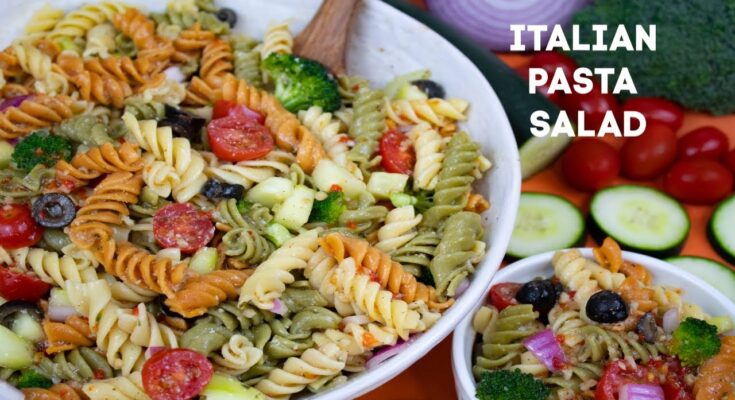Italian Pasta Salad Recipe: Who doesn’t love a fresh and vibrant bowl of Italian pasta salad? Whether it’s a summer picnic, a potluck, or a simple family dinner, this dish is a showstopper. Its colorful combination of tender pasta, crisp vegetables, tangy dressing, and bold flavors makes it a crowd favorite.
What Makes Italian Pasta Salad Special?
Italian pasta salad stands out because it’s as versatile as it is delicious. Unlike creamy pasta salads, the Italian version is light, zesty, and refreshing, thanks to a vinegar-based dressing. Plus, it’s highly customizable—swap ingredients based on your taste, and you still end up with a winning dish.
Ideal Occasions to Serve Italian Pasta Salad
This salad is perfect for casual gatherings, BBQ parties, and even meal preps for busy weeks. Since it’s served cold, it’s also an excellent choice for outdoor events or lunchboxes.
Ingredients for Italian Pasta Salad
Essential Ingredients
Here’s what you’ll need to make a classic Italian pasta salad:
- Pasta (fusilli, penne, or rotini)
- Cherry tomatoes
- Bell peppers (red, yellow, or green)
- Cucumbers
- Red onions
- Olives (black or green)
- Salami or pepperoni
- Mozzarella balls or shredded mozzarella
- Italian dressing (store-bought or homemade)
Optional Add-Ons for Extra Flavor
Enhance your pasta salad with these extras:
- Artichoke hearts
- Sun-dried tomatoes
- Fresh basil or parsley
- Parmesan cheese
- Banana peppers
Preparing the Pasta
Choosing the Right Type of Pasta
The key to a perfect pasta salad is choosing the right pasta shape. Opt for short, sturdy types like fusilli or rotini. Their grooves hold the dressing and toppings, ensuring every bite is flavorful.
Cooking the Pasta to Perfection
- Boil water in a large pot and add salt generously—it should taste like the sea.
- Cook the pasta according to package instructions until it’s al dente (firm but cooked).
- Drain and rinse with cold water to stop the cooking process and cool the pasta.
Preparing the Vegetables and Add-Ins
Fresh Vegetables for a Crunchy Bite
Fresh vegetables are the backbone of a good Italian pasta salad. Here’s how to prepare them for the perfect crunch and flavor:
- Cherry Tomatoes: Halve these bite-sized gems for a burst of sweetness in every bite.
- Bell Peppers: Chop into small, uniform pieces to ensure they mix evenly throughout the salad.
- Cucumbers: Use seedless cucumbers for a crisp texture and minimal water content. Peel them if you prefer a smoother look.
- Red Onions: Thinly slice for a mild, tangy kick. Soak in cold water for 10 minutes if you want to reduce their sharpness.
- Olives: Slice black or green olives to add a salty depth to your salad.
Meats, Cheeses, and Other Additions
Elevate your salad with flavorful protein and cheese options:
- Meats: Salami, pepperoni, or prosciutto are excellent choices. Slice them into small strips or cubes for easy mixing.
- Cheeses: Mozzarella balls (bocconcini) work wonderfully. If you prefer a sharper flavor, go for shredded Parmesan or crumbled feta.
- Other Additions: Artichoke hearts and sun-dried tomatoes are great for an extra Italian touch.
Crafting the Perfect Dressing
Ingredients for a Classic Italian Dressing
A homemade dressing can make all the difference. Gather these ingredients:
- Olive oil
- Red wine vinegar
- Dijon mustard
- Garlic (minced)
- Italian seasoning
- Salt and pepper
- A pinch of sugar (to balance acidity)
Tips for Balancing Flavors
- Emulsify the Dressing: Whisk the olive oil and vinegar thoroughly to ensure they don’t separate.
- Taste-Test: Adjust seasoning as needed. Add more sugar if it’s too tangy or more vinegar if it’s too mild.
- Let it Rest: Allow the dressing to sit for at least 10 minutes so the flavors can meld together.
Step-by-Step Guide to Assembling the Salad
Mixing Pasta and Vegetables
Start by combining the cooked and cooled pasta with your chopped vegetables in a large mixing bowl. Make sure the bowl is big enough to toss everything without spilling.
Incorporating Protein and Cheese
Add your sliced meats and cheeses next. This ensures that these heavier ingredients don’t sink to the bottom of the salad.
Tossing Everything with the Dressing
Pour your prepared dressing over the salad gradually. Toss gently but thoroughly to coat all ingredients evenly. Pro tip: Save a little dressing on the side to refresh the salad just before serving.
Serving Suggestions and Presentation Tips
Garnishes to Enhance Visual Appeal
Finish your salad with fresh garnishes like chopped parsley, torn basil leaves, or a sprinkle of Parmesan cheese. This not only adds flavor but also makes the dish look inviting.
Best Ways to Serve the Salad
Serve the pasta salad in a clear glass bowl to showcase its vibrant colors. Pair it with crusty bread or grilled chicken for a complete meal.
Tips and Tricks for the Best Italian Pasta Salad
How to Prevent Soggy Pasta
- Don’t overcook the pasta—it should remain firm to the bite.
- Drain it thoroughly and let it cool before adding to the salad.
Storing Leftovers Properly
Store leftovers in an airtight container in the refrigerator. The salad tastes even better the next day, as the flavors deepen over time. Just refresh it with a bit of extra dressing before serving.
Variations of Italian Pasta Salad
Vegetarian Version
Skip the meats and focus on adding more vegetables like roasted red peppers or grilled zucchini. Cheese lovers can double up on mozzarella and Parmesan.
Gluten-Free Adaptation
Use gluten-free pasta made from rice, quinoa, or chickpeas. Ensure all other ingredients, like the dressing, are also gluten-free.
Low-Calorie Option
Swap out salami and cheese for grilled chicken or turkey. Opt for a light dressing with less oil and more vinegar to cut down on calories.
FAQs about Italian Pasta Salad Recipe
What pasta is best for Italian pasta salad?
For an authentic Italian pasta salad, opt for pasta shapes that can easily hold onto the dressing and mix-ins. Fusilli, rotini, and farfalle (bow tie pasta) are popular choices due to their grooves and shapes that catch bits of veggies, cheese, and dressing.
How long can I store Italian pasta salad in the fridge?
Italian pasta salad can be stored in the refrigerator for up to 5 days when kept in an airtight container. It’s perfect for making ahead, allowing the flavors to meld together beautifully over time.
Is Italian pasta salad gluten-free?
Traditional Italian pasta salad is not gluten-free as it uses wheat-based pasta. However, you can easily make it gluten-free by substituting with gluten-free pasta made from rice, corn, or quinoa.
What are some must-have ingredients in Italian pasta salad?
An authentic Italian pasta salad typically features ingredients like cherry tomatoes, olives, cucumbers, red onions, and mozzarella cheese. For added flavor, include Italian herbs like basil or oregano, and a generous drizzle of Italian dressing or extra virgin olive oil.
Can I make Italian pasta salad vegan?
Yes, you can make a vegan Italian pasta salad by omitting cheese and using a vegan dressing. Swap out traditional cheese for vegan cheese or add more veggies like artichoke hearts and bell peppers for a filling and flavorful dish.
Conclusion
Making Italian pasta salad is as easy as it is rewarding. With its medley of textures and flavors, it’s the ultimate crowd-pleaser that works for any occasion. Follow this guide, experiment with ingredients, and you’ll have a dish that’s sure to impress.



